An article about verification through digital sources.
I do my research on Swedish-born soldiers who fought and fell on the Western Front in the First World War, and I usually start in a situation where I start with scanned basic documents from military archives from the countries I know that these Swedish-born soldiers fought for. In my research, it is important for me to verify that the individuals were born in Sweden, that they really are the individuals mentioned in the documents, as part of the boundaries that I set as a criterion.
In my opinion, these documents are written by themselves, or interpreted by someone who writes down what the individuals answer to each question, and the difference can contribute to a lot of research into what the documents actually say.
Some documents are written by hand while others are typed, and this applies to all the facts in the documents. Here you have to be prepared for the fact that letters from the Scandinavian alphabet do not write as we usually do and that the text is sometimes phonetically written down, that sometimes provides space for further research on what is really meant.
This problem occurs especially when it comes to name of places. Another thing that often emerges is that individual Swedish names are often simplified and this is something you really have to take with you in your verification of the facts that appear in the documents. This is something I often encounter. John is often Johan as an example.
In most cases, it is relatively easy to follow up on the information mentioned in the documents, both regarding place and date of birth, but there are a number of cases where I am really stuck and partly had reason to question the facts that are disclosed.
However, I sometimes end up in situations where the information from relatively reliable sources, such as the Swedish National Archives, does not match the information that the individuals themselves state in the documents to the military units in which they participated when they fought on the Western Front.
Above all, it is sometimes difficult to interpret the place of birth and especially the date of birth. This differs significantly between different countries where the Canadian documents are asked for “date of birth” while those in the Australian documents are asked for age, which gives different situations regarding follow-up.
The reason why data diverges may depend on how much perception they have of their background at the time the documents are filled in, which may be due to the age they were at when they emigrated to the countries for which they then fought. There is a hint that those who fought for the Canadian units emigrated earlier than those who fought for the Australian units, where it seems that recruitment took place later in life, after emigrating more in adulthood.
One method of trying to fill in gaps in the information is to look for this in other digital sources, both completely open sources, and from sources behind payment wall. These sources often contain information that is a mixture of information from secure sources and information that users enter themselves, and this sometimes causes problems.
Here, facts about the date of birth, may appear as assessed and then become incorrect, which are then combined with estimated places where the individuals were born, due to the fact that there are often places with the same name in Sweden.
If the individuals then have common Swedish first and last names, it contributes to a more difficult task to try to verify the information. In some cases, I have taken long detours that eventually led to me finding the right individual and being able to verify their background, but here it is important to have a little imagination, and it has sometimes yielded results.
Here are a couple of examples where I really had to work more from different angles to be able to verify the information, and a couple of examples where I still have not reached the goal.
Edward Pearson was born on November 5, 1888, fought for the 2nd Canadian Infantry Battalion and fell on the Western Front in 1915, mentioning in his documents that he was born in Stockholm, but I had to seek a detour through his mother who is listed as Martha in the documents, and his father as listed as PO Pearson and Peter O Pearson. Through the detour, I finally get the couple Per Olof Persson and Märtha Eriksson has a son named Per Erik who was born November 5, 1888 in Valbo, Gävle, where it appears that he is also called Edward in the archives. I can now with high probability say that this is the individual I was looking for.

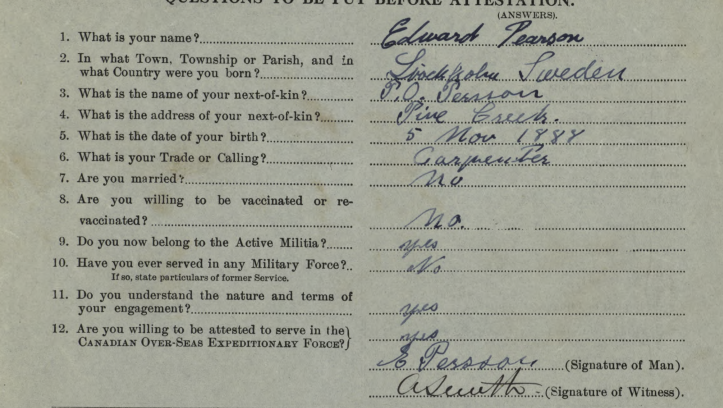
In another case, I’m looking to be able to verify the birthplace of Charles Anderson, who was born on October 7, 1890 in Vedtskofla according to the documents, and who fights for the 13th machine gun company in the Australian Imperial Forces (AIF), where he falls on the western front in 1918 It took a while before I figured out that Vedtskofla is Vittskövle in Skåne, but in the end I was able to verify Charles to be Carl Andersson from Vittskövle.
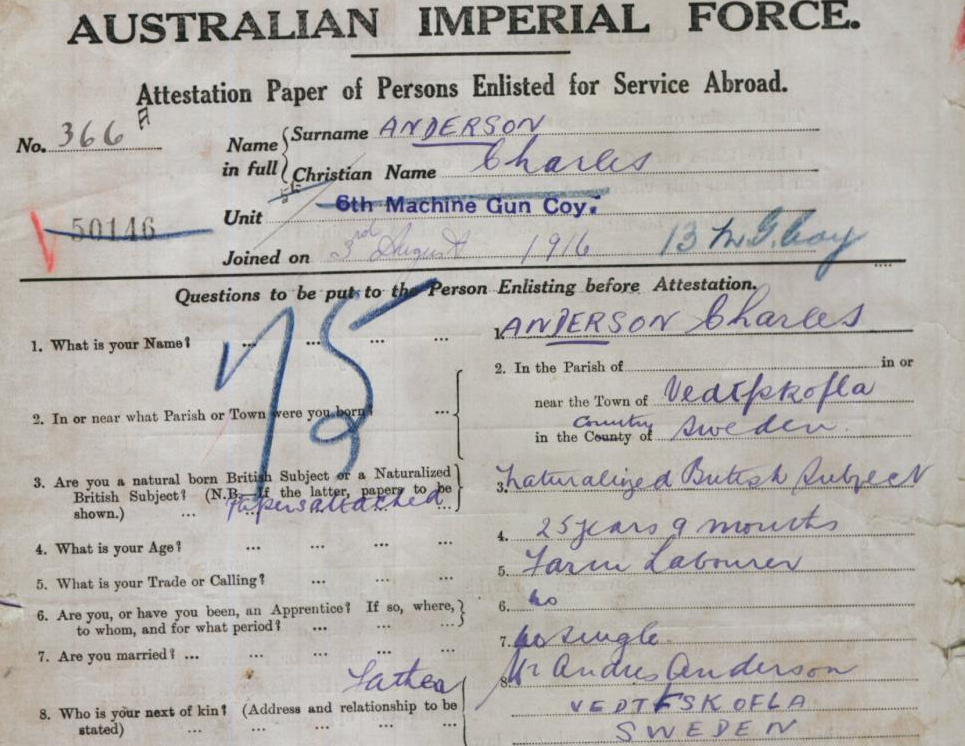
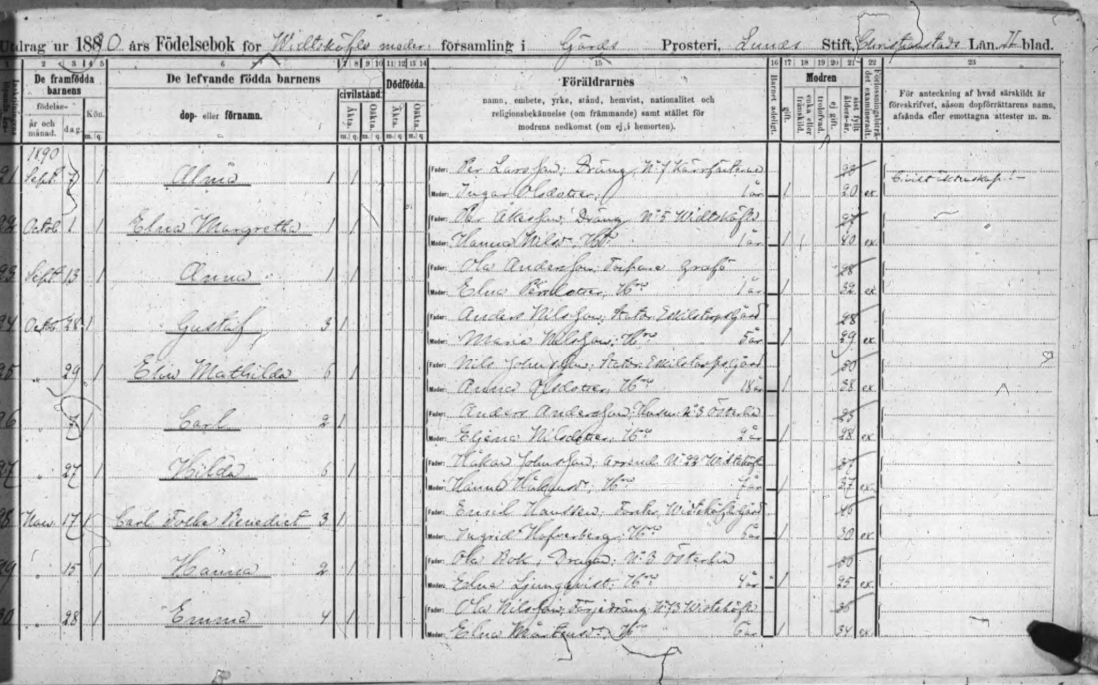
I’m still trying to verify the individual Axel Renyus Carlson, which has proved difficult. The documents from his unit states that Axel was born in Kalmar, which may mean a number of small towns around Kalmar, but which is a good value for further research. There are a number of Axel Renyus, who in Swedish is assessed to be Axel Renius, and in the documents he states that he was born on March 28, 1890. There is an Axel Renius in Kalmar who was born in 1890, but neither of his parents is John Carlson who he states in his papers. However, there is an Axel Renius who was born in Älghult, Kronoberg County, on March 23, with a father named Carl Johan Johansson. It is also mentioned in the house interrogation books that Axel is taken to North America as a child, by the maid in the house, who does this without permission. This may be the Axel I’m looking for, but so far I’m not done.

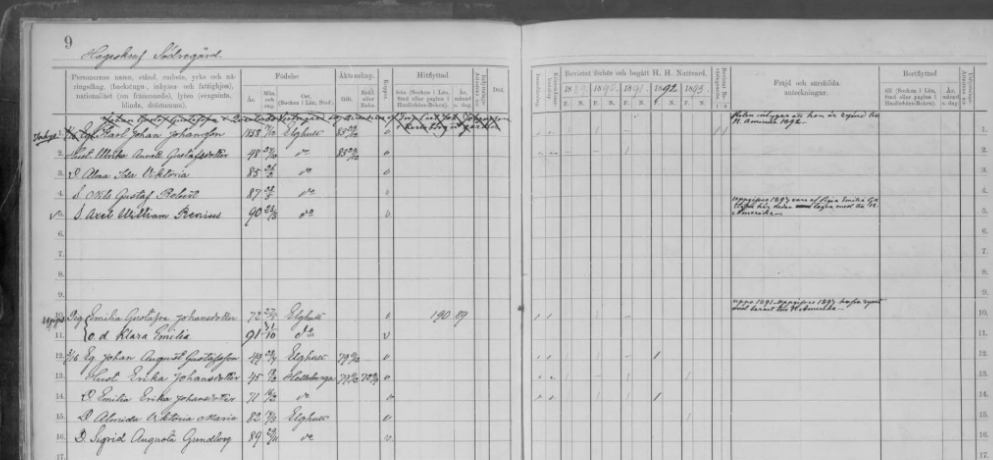
Gustav Albin Gustafson states in his papers, when he registers for AIF in Australia, that he was born in Gustaburg, which may be Gustavsberg, which is found in a number of places in Sweden, and it may be a bit far-fetched, it is Gothenburg, but I have not got some hit there. He writes himself that he is 34 years and two months old in August 1915, which should mean that he was born in 1881. I then find out from a secondary source that he was born on March 4, 1880, which does not rhyme with the age he himself indicates, but does he indicate correctly? It mentions that the individual’s name is Gustav Albin Gustafson, a photo is of him, and it is mentioned that he fell on the western front on September 4, 1916, which is consistent with the information available from the unit. But I can not find any Gustav Albin with this information in the National Archives, so here I have to continue working.
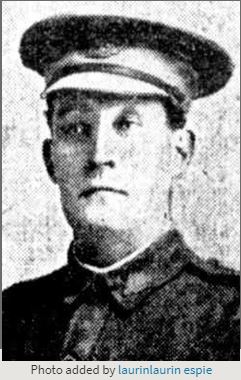

There are a number of other examples that I work with, and currently I have about 90 Swedes that I have verified out of the about 119 that I have in my database to date. My goal is to have verified at least 100 individuals, which I then take with me further in my research.
I also have individuals in my database where there is very scarce information but where I linked individual and date of birth and place, but where I still do not have information about where they fell on the western front. This mainly concerns the individuals who fought in the French Foreign Legion.
It is important to try to verify digital information through as secure sources as possible and to have a somewhat critical approach to the sources that contain information, both from the sources that are considered secure, and from sources that have largely provided information from many different sources, which may not be properly secured.
I still see myself as an amateur when it comes to research about Swedish born individuals in The Great War, the specific history about the world war, and also when it comes to methods, but I learn all the time, and it is really interesting!
In 2021, I hope that I will have the opportunity to make my trips to the battlefield, to be able to document the at least 100 individuals I am aiming for, to be able to visit the places where they fell and where they are buried and remembered.
